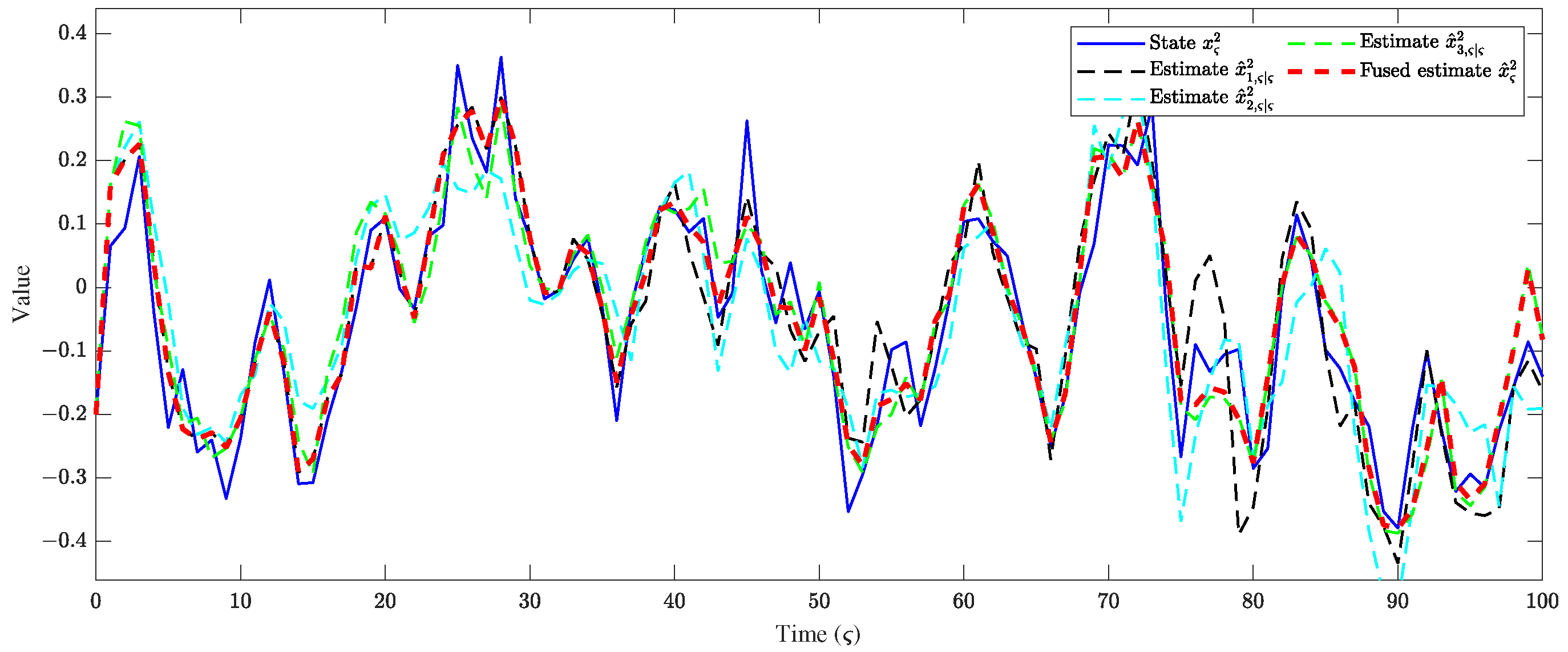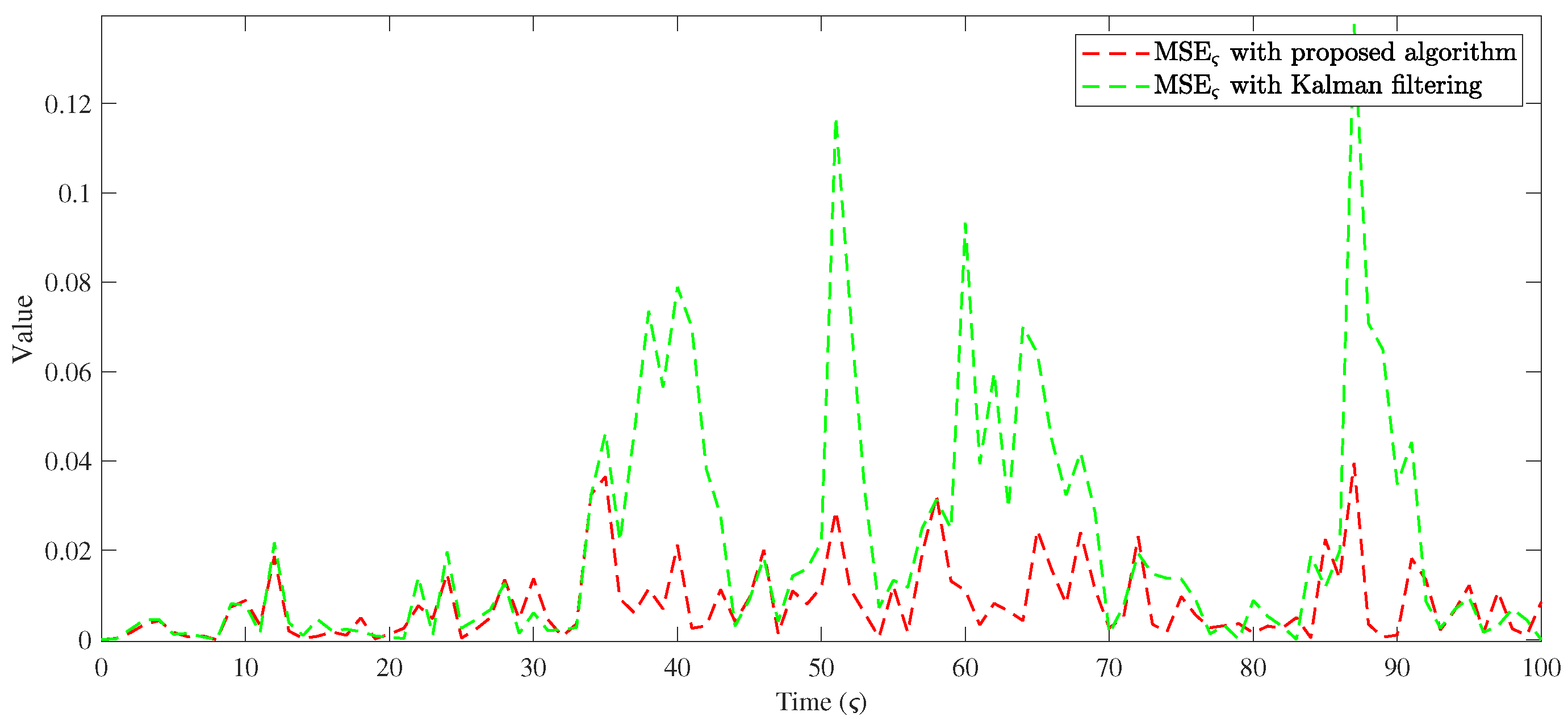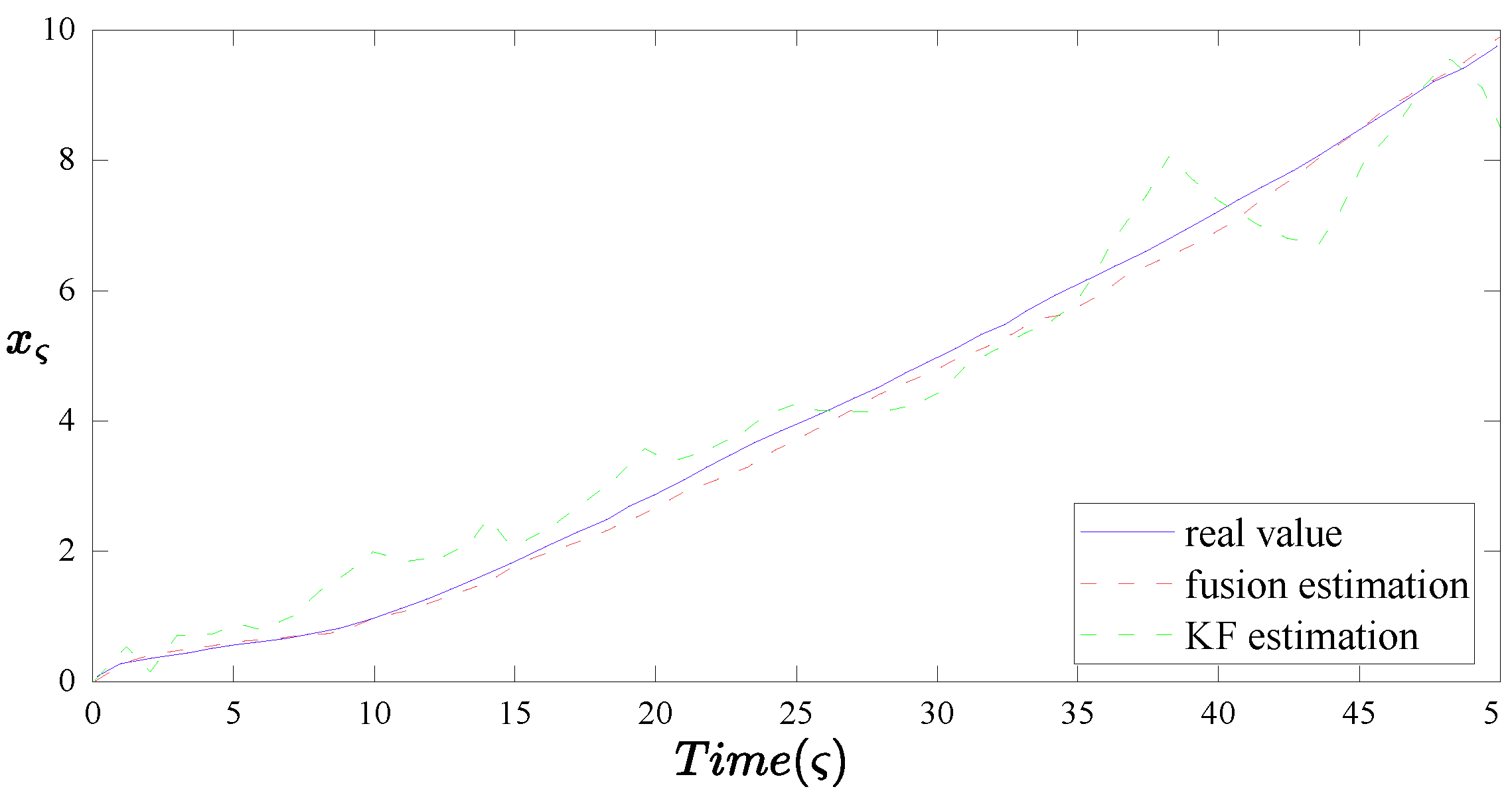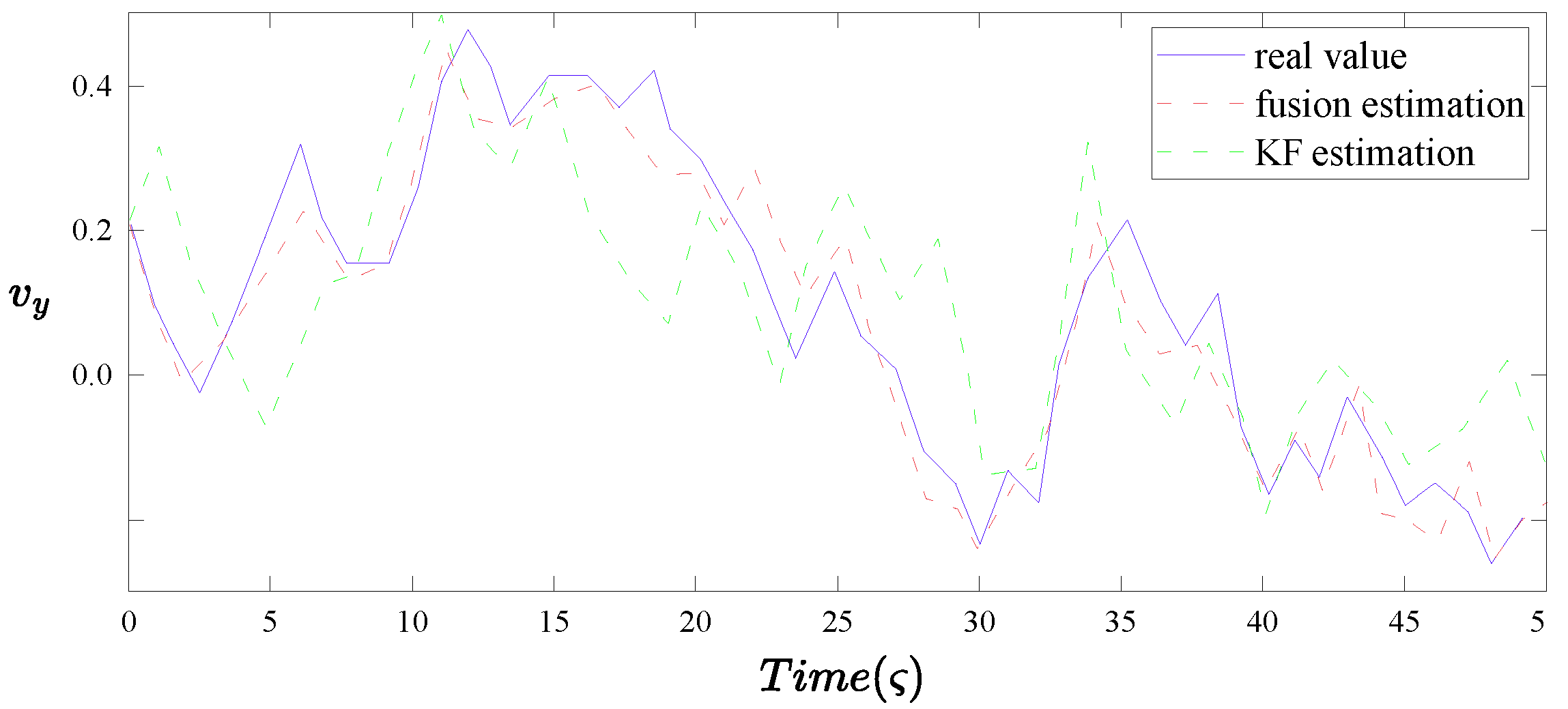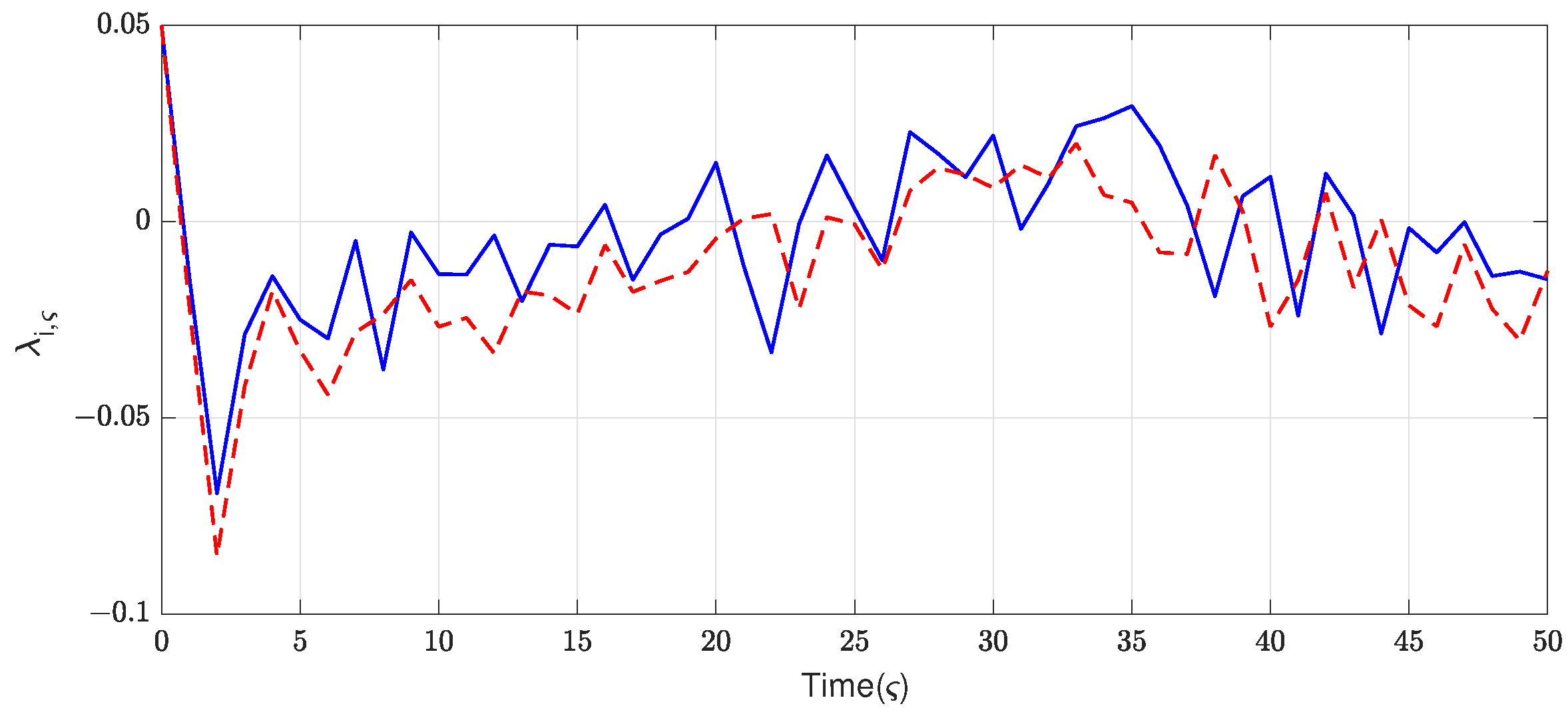1. Introduction
Over the past few decades, the issue of multi-sensor information fusion has garnered significant research interest within the realms of signal processing and control engineering owing to the increasing requirements of the system’s stability and reliability in practical applications. Accordingly, numerous multi-sensor information fusion strategies have been extensively investigated in a variety of multi-sensor systems with examples consisting of environmental monitoring, intelligent transportation, mobile robot localization, and smart grids, etc. [
1,
2,
3]. As a typical technology in multi-sensor information fusion process, the fusion filtering/state estimation scheme can be roughly classified as the distributed fusion scheme [
4,
5,
6] and the centralized fusion scheme [
7,
8,
9]. The distributed fusion scheme utilizes the local estimates generated by individual local estimators to obtain the fused estimates, while the centralized fusion scheme directly processes all sensor measurement data at a fusion center to produce the fused estimate. Although the centralized fusion approach stands out with its optimal performance under fault-free sensor conditions, the distributed fusion method has gained widespread adoption due to its enhanced robustness, flexibility, fault tolerance, and lower resources consumption [
10,
11,
12].
In real-world applications, it is sometimes impractical (or even impossible) to overlook parameter uncertainties when constructing the system models. Moreover, it should be pointed out that such parameter uncertainties are likely to occur in a random form for the sake of analytical tractability, which inevitably introduces significant complexities to system analysis and impairs estimation performance [
13,
14]. The so-called randomly occurring parameter uncertainties (ROPUs) are usually caused by the disturbances of the external or internal circumstances, such as network-induced structural failures, abrupt destabilization of network load, and random repairs of physical components [
15,
16,
17]. Up to now, the study of developing appropriate estimation/control algorithms in the presence of ROPUs has emerged as a cutting-edge research hotspot with fruitful results [
18,
19,
20]. For instance, in [
19], a robust
filtering scheme has been investigated in the continuous-time nonhomogeneous Markov jump nonlinear systems subject to ROPUs. The maximum-correntropy-based Kalman filtering approach has been discussed in [
20] for the time-varying linear systems against ROPUs and non-Gaussian noises. It is worth noting, however, that some uncertainties may exhibit statistical dependencies or be partially predictable. For instance, environmental sensor readings such as humidity may depend on temperature accuracy, and structural uncertainties may relate to physical degradation patterns. In this study, the ROPU framework is adopted as a general and flexible modeling approach, which enables us to characterize a wide range of uncertainties and derive tractable filtering solutions. Such a probabilistic abstraction captures many practical effects while maintaining analytical feasibility; yet, more structured or state-dependent uncertainties will be an important direction for future work.
Thus, far, existing filtering/state estimation algorithms for network systems have been primarily devoted to tackling performance degradation caused by network-induced phenomena (e.g., fading channels, packet dropout, coupling uncertainties, and malicious cyber-attacks), which are predominantly induced by the constraints of network communication capacity in practical engineering [
21,
22,
23]. In fact, all the system components including sensors, estimators, and controllers, where signals are transmitted via the shared communication channel, are inevitably subject to the negative influence of network-induced phenomena [
24]. Among them, channel fading is commonly encountered during data transmissions owing mainly to the occurrence of path loss, multi-path propagation, and the shadowing effects of obstacles. Under the unreliable channel with such fading phenomenon, the amplitude and phase of the transmitted signal would inherently undergo random changes [
25,
26]. Obviously, if the phenomenon of channel fading cannot be addressed effectively, it will not only lead to the degradation of signal quality but also severely impact the estimation performance. As a result, the channel fading phenomenon has recently been quite popular in filtering/state estimation problems [
27,
28,
29]. For the sake of analytical simplicity, the majority of existing literature has supposed that the fading coefficients of wireless channels are constant or independent at each time step. However, such an assumption may not be valid in light of the memory effects inherent in practical wireless communication channels, which can naturally result in the time-correlated characteristics of fading channels [
30,
31]. In this case, the time-correlated fading channels (TCFCs) have aroused substantial research enthusiasm from various fields, and some elegant results have been reported [
32,
33,
34]. Nevertheless, to the best of the authors’ knowledge, the recursive fusion state estimation issue for multi-sensor systems under TCFCs has not received sufficient research despite its potential application significance, not to mention the case where the considered systems are influenced by ROPUs, which is our primary research motivation.
Traditional networked control systems typically adopt fixed-time interval sampling due to its simplicity, predictability, and ease of implementation in real-time scheduling frameworks. This approach is especially favored in safety-critical domains—such as aerospace systems, medical devices, and industrial automation—where deterministic update intervals support system certification, traceability, and regulatory compliance. However, in increasingly complex and resource-constrained environments—such as wireless sensor networks, large-scale multi-agent systems, and mobile robotics—fixed-period sampling may result in inefficient utilization of bandwidth, energy, and computational resources. This inefficiency becomes more prominent when the underlying system dynamics are slow, redundant, or vary across operational modes.
To address these limitations, the static event-triggered mechanism (SETM) was proposed as a hybrid strategy combining periodic sampling with conditional data transmission. Such mechanisms enable regular monitoring of system behavior while transmitting data only when certain predefined conditions related to estimation errors or state deviations are met [
35]. For example, in [
36], event-triggered control was developed to handle synchronization tasks in discrete-time stochastic dynamic networks. While SETM reduces unnecessary transmissions, its reliance on fixed triggering thresholds often limits responsiveness and flexibility, particularly in time-varying or uncertain environments. Fixed thresholds can lead to either excessive triggering in stable conditions or delayed responses in dynamic or safety-critical transitions.
To improve adaptability and resource efficiency, the dynamic event-triggered mechanism (DETM) has been introduced as a more advanced solution. DETM incorporates memory-dependent terms and adaptive threshold regulation strategies that dynamically adjust the triggering conditions based on recent system evolution [
37]. This dynamic flexibility allows the system to maintain estimation and control performance while significantly reducing communication load. From a practical perspective, DETM is especially advantageous in scenarios such as low-speed autonomous vehicles operating in mixed environments, or remote monitoring systems with stringent power and bandwidth constraints. Moreover, DETM supports hybrid triggering schemes that combine fixed and dynamic components, enabling system designers to meet both regulatory and performance requirements.
From an application standpoint, DETM is increasingly appealing in a wide range of intelligent systems where resource constraints and adaptivity are critical. For example, in industrial mobile robotics, a representative implementation is presented in [
38], where a hardware-in-the-loop experiment using an omnidirectional patrol robot demonstrated that the proposed DETM framework could reduce wireless data transmissions by approximately 90% without significantly compromising tracking accuracy. Similarly, ref. [
39] applied event-triggered mechanisms to remote data transmission in wearable medical devices, significantly reducing data transmission rates while maintaining the performance of the Dynamic SpO2 Index (DSI) assessment.
Inspired by the previous discussions, most multi-sensor fusion state estimation schemes overlook the negative effects induced by ROPUs, TCFCs, and communication congestion in densely deployed scenarios, let alone the application of a recursive approach. Therefore, this paper aims to design a recursive fusion state estimation scheme to address the state estimation problem of multi-sensor systems under the challenges of random parameter uncertainties, channel fading, and communication congestion. Along this research line, three inevitable concerns must be addressed: (1) how to describe and solve the time-correlated features of fading channels, (2) how to appropriately compensate for the joint effects of ROPUs, TCFCs, and the DETM on filtering performance, and (3) how to develop a recursive fusion state estimation strategy for multi-sensor systems under the constraints of ROPUs, TCFCs, and DETM to achieve the desired fusion estimation? Therefore, the main contribution of this paper is to design a recursive fusion state estimator that addresses the aforementioned three concerns and is suitable for multi-sensor systems involving ROPUs, TCFCs, and DETM.
Based on the above analysis, the primary contributions of this paper are as follows:
The recursive fusion state estimation problem for multi-sensor systems with random parameter uncertainties subject to time-correlated channel fading under dynamic event triggering is addressed;
A unified framework is established through the use of an auxiliary variable, which captures the dynamic characteristics of both the system state and the channel coefficients;
A local estimator capable of tolerating the impacts from ROPUs, TCFCs, and DETM is designed to minimize the upper bound of the local estimation error covariance (EEC), and ultimately, all the local estimates are fused using the covariance intersection fusion strategy (CIFS).
Finally, experimental results are provided to validate the effectiveness of the proposed recursive fusion state estimation strategy.
The structure of this paper is outlined as follows: In
Section 2, a multi-sensor time-varying system including ROPUs, TCFCs, and DETM is constructed, and the corresponding local estimator is established. In
Section 3, the recursive fusion state estimation algorithm is proposed, ensuring the convergence of the upper bound of the local EEC with the desired local estimator gains, and fusion estimates are obtained using CIFS at the fusion center.
Section 4 presents simulation experiments to test the effectiveness of the proposed recursive fusion state estimation approach. Finally,
Section 5 concludes this work. For ease of reference, a comprehensive symbol table is provided in the
Appendix A.
2. Problem Formulation
Before presenting the system model and problem setup, we first introduce some notation used throughout this paper for clarity.
Notation: The notations applied in this paper are standard unless otherwise pointed out. is the n-dimensional Euclidean space; I and 0 are, respectively, the identity matrix and zero matrix with compatible dimensions; , and stand for the transposition, inverse, and trace of the matrix M, respectively; () represents that is a positive definite (positive semi-definite) matrix for the symmetric matrices X and Y; means the probability of event “∗” occurring; is used to mean the mathematical expectation of the stochastic variable ⋆.
Figure 1 illustrates the proposed fusion state estimation framework for multi-sensor systems, which is divided into four functional modules: the sensor side, communication channel, node side, and fusion center.
The system is equipped with multiple sensors, each associated with a DETM. DETM is applied at the sensor side to regulate the frequency of data transmission, thereby alleviating communication burden while maintaining estimation performance. It adaptively determines whether to transmit the current measurement data based on predefined triggering conditions, effectively suppressing redundant communication.
Once the transmission is triggered, the measurement data are sent over TCFCs, which reflect realistic wireless communication scenarios. These channels exhibit temporal correlations in signal degradation caused by multipath propagation, path loss, and occlusion, posing significant challenges to reliable and timely data delivery.
At each node, a local estimator independently performs state estimation based on the received measurements. These estimators are designed to be robust against ROPUs, which may arise from environmental disturbances, structural changes, or sensor/component failures.
Finally, all local estimates are transmitted to the fusion center, where they are integrated through CIFS. This strategy ensures that the global state estimate remains consistent and accurate, enhancing the system’s robustness and fault tolerance under both modeling uncertainties and complex communication conditions.
The considered multi-sensor systems with randomly occurring parameter uncertainties are described by:
where
stands for the system state and
denotes the
i-th sensor measurement output.
,
and
are the time-varying matrices with given dimensions.
and
, respectively, represent the zero-mean Gaussian white noise variables satisfying covariance
and
, which stand for the process noise and measurement noise. Meanwhile, the parameter uncertainties
is a time-varying real-valued matrix satisfying the following condition:
where
and
are time-varying matrices with known dimensions,
denotes the function of uncertainties which is an unknown time-varying matrix with the following constraint:
In addition, the Bernoulli distributed random variable
is employed to characterize the occurrence of parameter uncertainties, which takes a value of 0 and 1 with the following probabilities:
where
is a given constant.
For the purpose of energy-saving, DETM is conducted to regulate the frequency of transmissions. We define the triggering instants by
, which is determined by
Here,
and
are given positive scalars,
,
denotes the transmitted measurement at latest event time, dynamic variable
satisfies the following relationship:
where
is a given scalar and
represents the initial value.
In conventional periodic transmission schemes, the measurement signals are regularly transmitted through TCFCs. Under such conditions, the received measurements can be modeled as:
where
is the channel noise which satisfies the Gaussian white noise sequence with mean
covariance
. The
i-th fading channel coefficient
can be described by
Here, represents the time-correlated factor and denotes an independently Gaussian distributed stochastic variable with mean covariance .
However, in this paper, the measurement signals are transmitted only at the triggering instants determined by DETM. Due to the irregular nature of such transmissions, the received signal under DETM also exhibits a temporal deviation. Accordingly, we define a channel-induced deviation term as , which captures the discrepancy between the newly received signal and the last successfully transmitted value under DETM.
Assumption 1. All the mentioned noise signals , , and are supposed to be mutually independent.
Assumption 2. The initial value and fading channel coefficient with the means and and covariances and are mutually independent and also uncorrelated with the above noise signals , , and .
By introducing
, it is followed from Equations (
1) and (
8) that
Then, by setting
, the augmented model can be constructed from Equations (
1) and (
9) as follows
where
For the augmented system Equation (
10), we can construct the local estimator with the following expression
where
and
denote the local one-step prediction and the local estimation of the augmented system state
.
stands for the
i-th local estimator parameters to be designed.
Define the local one-step prediction and the local estimation error as
and
, respectively. Clearly, it can be obtained from Equations (
10) and (
11) that
Then, we can define the local one-step prediction error covariance and the local EEC of the augmented system state
as
and
, respectively, which can be determined by the following forms
Let be the local estimate of state from the i-th estimator and be the corresponding EEC. In this paper, the main aim is to find the estimate such that the upper bound on EEC is ensured, i.e., , where the estimation process is subject to the negative effects of TCFCs and ROPUs. Then, the estimator gain is recursively designed to minimize the derived upper bound. Furthermore, the fusion of n local estimates of state will be conducted to obtain the fused estimate.
Obviously, we can easily obtain
and
with the help of the following equations
So that, our goals can be equivalent to deriving an upper bound on EEC , i.e., , and then the upper bound is minimized by selecting appropriate estimator gain . Ultimately, CIFS is utilized to fuse all the local estimates of .
Remark 1. The purpose of this paper is to study the recursive fusion state estimation issue for multi-sensor systems with ROPUs and TCFCs. In order to overcome all challenges posed by ROPUs and TCFCs, we will present the following solutions: (1) A random variable obeying the Bernoulli stochastic distribution is used to denote the occurrence probability of parameter uncertainties, which is determined by norm-bounded unknown matrices. (2) Wireless channels that perform the function of transmitting signals are considered to face the challenge of time-correlated fading. Therefore, an auxiliary variable is employed to construct an augmented model reflecting the simultaneous dynamics of the fading coefficients and system states. (3) Due to the effects induced by ROPUs and TCFCs, it is impossible to calculate the precise EEC. As an alternative method, the minimum upper bound of the local EEC will be provided by parameterizing the estimator gain matrices.


